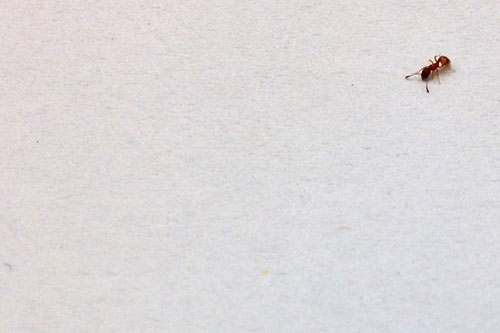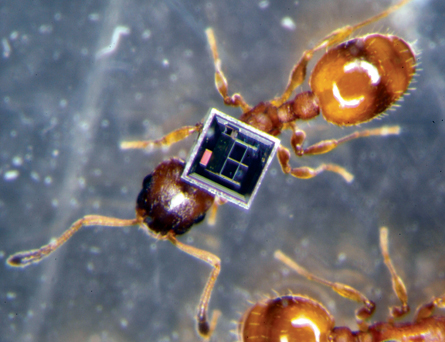No talking while walking

Complex systems in biology have several levels of organization, establishing a hierarchy of systems and subsystems. An ant colony is a wonderful example with the highest level being the colony itself, formed by hundreds or thousands of insects, each individual ant formed by millions of cells including 105-106 neurons, and each cell formed by thousands of proteins and other molecules including nucleic acids.
It has been considered that decisions in the ant society were a bottom-up process arising from the genes to the cells to the individuals to the whole colony. However, there is an intense feedback between the different hierarchical levels, working simultaneously on many different time and length scales. In addition, these interactions are combined with the external, environmental information. This is a complicated procedure since planning a task and conducting it at the same time that new information is gathered can produce a contradiction between previous estimations and actual situation.
The movement of workers from one place to another is a basic process, both in its simplicity and in its importance for the group. Tracking individual ants moving inside the nest found a power-law relationship between a movement’s duration and its average speed. In addition, there is a universal speed profile for movements short and long showing that they mostly vary around a constant average speed.

Edmund Hunt and his colleagues from Bristol’s School of Biological Sciences studied the movement patterns of the house-hunting ants (Temnothorax albipennis) outside the nest, exploring a large arena under two different circumstances: when the arena was clean and when it was «enriched» with chemical inputs (pheromones or other cues) left by previous next-mates1. The idea was to understand how the behaviors of individual worker ants are determined by group interactions and how these interactions allow collective problem-solving abilities to emerge.
The researchers found that movements outside the nest mostly fluctuated around a constant average speed. This speed increased in anticipation of a longer movement, suggesting that movement durations were somehow determined before commencement, which implies that ants only intermittently respond to their social environment and that ants determine their next move at rest. There is a higher variation in speeds comparing outside the nest with inside it, as one might expect. However, there is an underlying similarity and hence predictability in the event speed profiles. This suggests similarity in the neural and/or physiological mechanism(s) determining movement characteristics across ants. Furthermore, this basic mechanism is retained across different regimes of social interactions, from the no cleaning treatment where the interaction was slight, to a small cavity with more than 100 ants and 50 brood items, where the interaction was intensive.
This study confirms that the duration of an activity event is determined before commencement in ants exploring outside their nest. This predetermination was inferred by considering the following: (i) the universal speed profile for events showing ants travelling at a constant speed, on average, for most of a movement; (ii) the low instantaneous speeds often reached during long events with high average speeds, which seems to rule out the possibility of higher average speeds causing longer events; and (iii) the observed sub-linear power-law relationship between the duration of a movement and its average speed, which indicates the existence of a persistent internal mechanism connecting these two variables. Hunt said: «an intermittent response to social information would be helpful to the individual ant by reducing the burden of information it has to process when moving around in its crowded society. It could also benefit the colony as a whole by moderating positive feedback effects, which may otherwise propagate social information of poor quality through the system. This would compromise the effectiveness of the ants’ decentralized task allocation system»2. The findings of this paper point to a simple, scalable movement algorithm operating endogenously in a similar manner across all T. albipennis workers, one that can be employed in foraging for work both inside and outside the nest. Maybe this can be extrapolated to other types of simple behaviors. Thus, ants did not get distracted by social information when on the move, possibly reducing information overload and enhancing the robustness of complex societies.
References
- Hunt ER, Baddeley RJ, Worley A, Sendova-Franks AB, Franks NR (2016) Ants determine their next move at rest: motor planning and causality in complex systems. Royal Society Open Science
- University of Bristol. “Ants respond to social information at rest, not on the fly.” ScienceDaily. (accessed January 16, 2016) ↩
2 comments
[…] por noesbasura | Feb 3, 2016 | Biology, Noticias, Science | 0 […]
UPDATE: The exactly same data used by Hunt et al was recently re-analyzed in this work.
http://rsif.royalsocietypublishing.org/content/15/143/20180223
The conclusions of our straightforward analysis (in which consecutive moves of different ants are randomly shuffled) clearly CONTRADICT Hunt et al conclusions that ants “determine” their next move at rest.